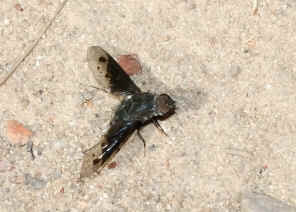|
| |
Family Bombyliidae
- This page contains pictures and information about Black Beeflies in Tribe
Anthracini
that we found in
the Brisbane area, Queensland, Australia.
-
- Beeflies in this subfamily are commonly known as Black Beeflies. They have their wing vein Rs forks very close to
cross vein r-m. They are close to the Exoprosopini except
they have a pencil of hairs at the tip of antenna. They are from small to medium
in size. Most of them are dark brown to black in colours, with black patterned on
hyaline wings. Most species have the white spots on abdomen.
-
- Black Beeflies are strong fliers, often found feeding on blossom, flying around dead or fire-blackened trees where mud wasps are building nests.
Some Black Beeflies species have the hill-topping habit.
-
- Anthracini larvae are parasites on larvae of other insects, including
wasps, flies, beetles, grasshoppers, lacewings, butterflies and moths. Females lay eggs near a potential host. The first instars is
free-living and will find the host within the ground or host nest. Later instars usually feed upon a single host. The pupa is armed with spines.
-
-
- Anthrax Beefly I

 - Anthrax maculatus, body length 10mm
- We saw this Beefly in Karawatha forest a few times. The Beefly is black
in colour with black patterns on hyaline wings. There is the white spots on
each side of the abdomen near the wing base. Visit this page
for more pictures and information
-
-
- Anthrax Beefly II

 - Anthrax torulus, body length 8mm
- Found on the footpath in Daisy Hill near Buhot Creek mid summer Dec 2008.
The fly was laying eggs into the sandy soil. Please also check this page
for more details.
-
-
- Anthrax Beefly III

 - Anthrax proconcisus, body length 8mm
- Many of those flies resting on the mud of a large fallen tree root. They
were still there even many weeks later. We saw in in Karawatha Forest during early
summer. We have more information and pictures in this page.
-
-
- Anthrax Beefly IV, White-tipped Anthrax Beefly
 - Anthrax confluensis, male, body length 8mm
- We found this fly in Karawatha Forest on Dec 2007. It was resting inside a
large burned tree hole. Its white abdomen tip became very noticeable in the
dark and black background. Only the male has the white tip, female is all black.
The Bee Fly flied away slowly after we took the above photo. Please also check
this page.
-
-
- Thraxan Beefly

 - Thraxan sp, body length 10mm, female, male
- Pictures were taken in Karawatha Forest during early summer. The fly was
resting on plants 0.2-0.3 meter above ground, seems waiting for something. It
was also found resting on rock and on floor. Please also visit this page
for more details.
-
-
- Thraxan Beefly ?
 - ? Thraxan sp. body length 10mm
- Picture was taken on Sep 2007. The fly looks like the Thraxan sp.
but not so sure.
-
- Reference:
- 1. Insects
of Australia, CSIRO, Division of Entomology, Melbourne University
Press, 2nd Edition 1991, p 759.
- 2. Insects of Australia and New Zealand - R. J. Tillyard, Angus
& Robertson, Ltd, Sydney, 1926, p364.
- 3. Bee Flies (Bombyliidae) - - by Giff Beaton, 2005.
- 4. Family
BOMBYLIIDAE - Australasian/Oceanian Diptera Catalog - Web Version, by
Greg Daniels.
- 5. Cryptic species diversity and character congruence: review of the tribe Anthracini (Diptera : Bombyliidae) in Australia - David K. Yeates and Christine L. Lambkin,
1998.
- 6. An evolutionary radiation of beeflies in semi-arid Australia: systematics of the Exoprosopini (Diptera: Bombyliidae) - Lambkin CL, Yeates DK & Greathead DJ, Invertebrate
Systematics, 2003.
[ Up ] [ Anthracini ] [ Exoprosopini ] [ Villini ]
| |
|










